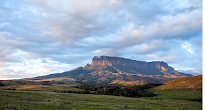Just added my Connectography Speech of Venezuela!
Check out the video and let’s learn about Venezuela together.
Connectography Speech for World Environment Day 2025 | Lee Chae Yeon (Venezuela) | 101
Mount Roraima, or Tefui, in Venezuela is an ancient tabletop mountain that features steep vertical walls and flat, plateau-like summits. It is part of the Guiana Tidal Zone, a geological structure that covers parts of Venezuela, Brazil, Guyana, and Suriname. The Guiana Tidal Zone consists of the Precambrian Period, and is said to be some of the oldest rocks on Earth. The formation of Mount Roraima began about 2 billion years ago, when erosion and weathering gradually wore down the surrounding rocks, leaving only isolated rocks, and as time passed, crustal uplift events led to the formation of Tefui. Thus, Mount Roraima is mainly composed of sandstone and is formed by the deposition and compression of sedimentary rock sand particles. In addition, the flat tabletop and vertical cliffs of Mount Roraima were formed by widespread erosion. The combination of weathering, rainfall, and river and river action gradually carved out the sandstone, creating the unique features we see today, and the erosion process continues to form the mountains, albeit at a slow rate. During the Red Turf (commonly known as the Ice Age), the region's climate was colder, and glacial activity covered the top of the mountain, which is said to have further affected the formation of Tefui, smoothing the surface and contributing to erosion patterns. As a result, we would like to know in detail why the top part of Mount Roraima is flat and how it was formed in the form of Table Mountain
Global greenhouse gas emissions caused by human activities have increased since the pre-industrial era, and between 1970 and 2004, they increased by 70%. Greenhouse gases act as a partial blanket of long-wave radiation from the surface. This blanket effect is called the natural greenhouse effect. Human activity enhances this blanket effect through the release of greenhouse gases. For example, the amount of carbon dioxide (CO₂) in the atmosphere has increased by about 35% in the industrial era, and this increase is known to be mainly due to human activity, especially fossil fuel combustion. These greenhouse gases stay in the atmosphere for a long or short period of time, changing the chemical composition of the Earth's atmosphere and causing climate change. In addition, an aerosol is a microparticle floating in the gas phase, and refers to the uniform distribution of liquid or solid particles in a fine form mainly in the gas such as air. Their size, concentration, and chemical composition are very diverse. Some aerosols are directly released into the atmosphere, and others are produced from the released compounds. Due to the combustion of fossil fuels and biomass, aerosols containing sulfur compounds, organic products, and soot have increased, and like greenhouse gases, industrialization due to human activities has particularly changed the amount of aerosols in the atmosphere, which is affecting climate change. Aerosols generated by human activities tend to be concentrated near source areas such as industrial areas because they remain in the atmosphere for only a few days. According to the National Climate Crisis Adaptation Center, the factors of the climate crisis are like this, but what direction should each country and the world take to prepare for these factors in the future?
Is Venezuela attempting to transform its economic structure by introducing renewable energy such as solar and wind power, and if so, what is the progress?
Hi, my name is Lee chae yeon. I am 16 years old and I am attending Incheon Haneul High School. My hobby is watching BOYNEXTDOOR videos. And I am researching a country called Venezuela.







